| Sharps Formation | |
|---|---|
| Stratigraphic range: Paleogene | |
| Type | Geological formation |
| Sub-units | Rockyford Member[1] |
| Underlies | Monroe Creek Formation[1] |
| Overlies | Brule Formation[1] |
| Location | |
| Region | |
| Country | |
The Sharps Formation is a geologic formation in South Dakota. It preserves fossils dating back to the Paleogene.[1]
The Sharps Formation is the namesake of the community of Sharps Corner, South Dakota.[2]
Fossil content
Color key
|
Notes Uncertain or tentative taxa are in small text; |
Mammals
Carnivorans
| Carnivorans reported from the Sharps Formation | ||||||
|---|---|---|---|---|---|---|
| Genus | Species | Location | Stratigraphic position | Material | Notes | Images |
| Archaeocyon | A. leptodus | Shannon & Jackson counties, South Dakota.[3] | Middle & upper part of the formation.[3] | Skull elements.[3] | A borophagine dog. |  |
| A. pavidus | Southeast corner of Sheep Mountain, Shannon County, South Dakota.[3] | Lower part of the formation.[3] | 2 partial skeletons.[3] | A borophagine dog. | ||
| Cormocyon | C. haydeni | Wounded Knee area, Shannon County, South Dakota.[3] | Upper part of the formation.[3] | Left maxillary (F:AM 49436).[3] | A borophagine dog. | |
| Cynarctoides | C. lemur | Shannon County, South Dakota.[3] | Lower & upper parts of the formation.[3] | Jaw elements.[3] | A borophagine dog also known from the John Day, Brule & Browns Park formations. | 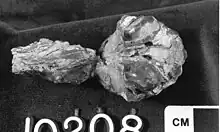 |
| C. roii | Wounded Knee Area, Shannon County, South Dakota.[1][3] | Upper part of the formation.[3] | Skull elements.[1][3] | A borophagine dog also known from the lower Arikaree Group | ||
| Cynodesmus | C. cooki | Wounded Knee Area.[1] | Mandibles.[1] | Reassigned to the genus Otarocyon.[3] | ||
| Ekgmoiteptecela | E. olsontau | Wounded Knee Area.[1] | Rockyford Member.[1] | Right ramus (SDSM 54247).[1] | Junior synonym of Hoplophoneus cerebralis.[4] | |
| Enhydrocyon | E. crassidens | Wounded Knee Area.[1] | Crania.[1] | A hesperocyonine dog also known from the Harrison Formation. | _fig._6.png.webp) | |
| E. pahinsintewakpa | Wounded Knee Area.[1][5] | Near the top of the formation.[5] | Right mandible.[1][5] | A hesperocyonine dog. | 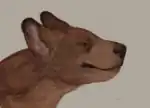 | |
| Hesperocyon | H. leptodus | Wounded Knee Area.[1] | Skull elements.[1] | Reassigned to the genus Archaeocyon.[3] | ||
| Hoplophoneus | H. cerebralis | Wounded Knee Area, South Dakota.[1][4] | Rockyford Member.[1] | Right ramus (SDSM 54247).[1] | A nimravid. |  |
| Leptocyon | L. douglassi | Wounded Knee Area.[6] | Maxillary fragments.[6] | A canine dog also known from the Toston & John Day formations. |  | |
| Mesocyon | M. robustus | Wounded Knee Area.[1] | Mandibles.[1] | A hesperocyonine dog. | ||
| "M." temnodon | Shannon County, South Dakota.[5] | Basal part and near the top of the formation.[5] | Rami.[5] | A hesperocyonine dog. | ||
| Nothocyon | N. geismarianus | Wounded Knee Area.[1] | Jaw elements.[1] | An arctoid formerly thought to be a canid, also known from the Monroe Creek Formation. | ||
| N. lemur | Wounded Knee Area.[1][3] | Jaw elements.[1][3] | Reassigned to Cynarctoides. | |||
| N. roii | Wounded Knee Area.[1][3] | Skull elements.[1][3] | Reassigned to Cynarctoides. | |||
| Otarocyon | O. cooki | Wounded Knee Area, Shannon County, South Dakota.[3] | Upper part of the formation.[3] | Partial rami.[3] | A small borophagine dog also known from the lower Arikaree Group. | 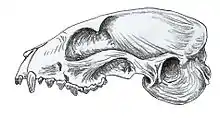 |
| Palaeogale | P. dorothiae | Wounded Knee Area.[1] | Fragment of right mandible (SDSM 53326).[1] | A palaeogalid. | 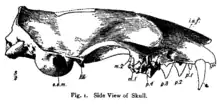 | |
| Paradaphoenus | P. tooheyi | South Dakota.[7] | Maxilla (LACM 21649).[7] | A bear-dog. | ||
| Philotrox | P. condoni | Wounded Knee area, Shannon County & Quiver Hill localities, Washabaugh County.[5] | Middle member.[5] | Skull and jaw remains.[5] | A hesperocyonine dog also found in the John Day Formation. | 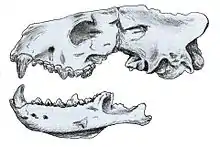 |
| Sunkahetanka | S. geringensis | Wounded Knee Area, Shannon & Jackson counties.[1][5] | Middle member.[5] | Jaw elements.[1][5] | A hesperocyonine dog also known from the topmost part of the Brule Formation. | 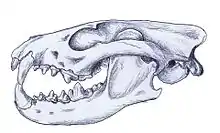 |
| S. pahinsintewakpa | Wounded Knee Area.[1] | Right mandible.[1] | Reassigned to Enhydrocyon. | |||
Eulipotyphlans
| Eulipotyphlans reported from the Sharps Formation | ||||||
|---|---|---|---|---|---|---|
| Genus | Species | Location | Stratigraphic position | Material | Notes | Images |
| Arctoryctes | A. terrenus | Wounded Knee Area.[1] | Humeri.[1] | A proscalopid also found in the Rosebud Formation. | ||
| Domnina | D. dakotensis | Wounded Knee Area.[8] | Mandible.[8] | A shrew. | ||
| D. greeni | Wounded Knee Area.[1][8] | Fragment of left mandible (SDSM 5895).[1] | A shrew. | |||
| Domninoides | D. evelynae | Wounded Knee Area.[1] | Mandibles.[1] | Species reassigned to Proscalops.[8] | ||
| Ocajila | O. makpiyahe | Wounded Knee Area.[1] | Fragment of left mandible (SDSM 56105) & LACM 9491.[1][8] | A gymnure. | ||
| Palaeoscalopus | P. pineridgensis | Wounded Knee Area.[8] | 2 dentaries.[8] | Junior synonym of Quadrodens wilsoni.[8] | ||
| Proscalops | P. evelynae | Wounded Knee Area.[8] | A proscalopid. | |||
| Quadrodens | Q. wilsoni | Wounded Knee Area.[8] | Dentaries.[8] | A talpid mole. | ||
| Talpidae | Genus indeterminate | Wounded Knee Area.[1] | Fragments of 2 upper molars (SDSM 5898).[1] | A talpid mole. | ||
| Trimylus | T. sp. | Wounded Knee Area.[8] | A dentary fragment (LACM 9380) formerly assigned to Ocajila.[8] | A shrew. | ||
Lagomorphs
| Lagomorphs reported from the Sharps Formation | ||||||
|---|---|---|---|---|---|---|
| Genus | Species | Location | Stratigraphic position | Material | Notes | Images |
| Megalagus | M. primitivus | Wounded Knee Area.[1] | Mandibles.[1] | A leporid. | ||
| ?Palaeolaginae | Wounded Knee Area.[1] | Fragment of left mandible (SDSM 5542).[1] | A leporid. | |||
| Palaeolagus | P. hypsodus | Wounded Knee Area.[1] | Skull & jaw elements.[1] | A leporid. | ||
| P. philoi | Wounded Knee Area.[1] | Jaw elements.[1] | A leporid. | |||
Metatherians
| Metatherians reported from the Sharps Formation | ||||||
|---|---|---|---|---|---|---|
| Genus | Species | Location | Stratigraphic position | Material | Notes | Images |
| Herpetotherium | H. youngi | Wounded Knee Area.[1] | Jaw elements & teeth.[1] | A herpetotheriid originally reported as Peratherium spindleri.[9] | ||
| Peratherium | P. spindleri | Wounded Knee Area.[1] | Jaw elements & teeth.[1] | Junior synonym of Herpetotherium youngi.[9] | ||
Primates
| Primates reported from the Sharps Formation | ||||||
|---|---|---|---|---|---|---|
| Genus | Species | Location | Stratigraphic position | Material | Notes | Images |
| Ekgmowechashala | E. philotau | Wounded Knee Area.[1] | Jaw elements.[1] | An adapiform. | ||
Rodents
| Rodents reported from the Sharps Formation | ||||||
|---|---|---|---|---|---|---|
| Genus | Species | Location | Stratigraphic position | Material | Notes | Images |
| Capacikala | C. gradatus | Wounded Knee Area.[1] | Skull elements.[1] | A castorid also known from the John Day Formation. | ||
| Capatanka | C. cankpeopi | Wounded Knee Area.[1] | Skull elements.[1] | A castorid. | ||
| Eumys | E. blacki | Wounded Knee Area.[1] | Right ramus (SDSM 5574).[1] | A cricetid. | ||
| E. woodi | Wounded Knee Area.[1] | Jaw elements.[1] | A cricetid. | |||
| Florentiamys | F. agnewi | Wounded Knee Area.[1] | Fragment of left ramus (SDSM 55120).[1] | A florentiamyid. | ||
| Grangerimus | G. dakotensis | Wounded Knee Area.[1] | Crania.[1] | A geomyid. | ||
| Heliscomys | H. species indeterminate | Wounded Knee Area.[1] | 4 isolated molars (SDSM 54365).[1] | A heliscomyid. | ||
| Hitonkala | H. andersontau | Wounded Knee Area.[1] | Skull elements.[1] | A heteromyid. | ||
| Meniscomys | M. hippodus | Wounded Knee Area.[1] | Left ramus (SDSM 56113).[1] | An aplodontid. | ||
| Palaeocastor | P. nebrascensis | Wounded Knee Area.[1] | Numerous skull elements.[1] | A castorid. | ||
| Pleurolicus | P. clasoni | Wounded Knee Area.[1] | Fragment of right ramus (SDSM 54388).[1] | A geomyid. | ||
| P. leptophrys | Wounded Knee Area.[1] | Right ramus (SDSM 53380).[1] | A geomyid also known from the Rosebud Formation. | |||
| Proheteromys | P. bumpi | Wounded Knee Area.[1] | Jaw elements & teeth.[1] | A heteromyid. | ||
| P. fedti | Wounded Knee Area.[1] | Right ramus (SDSM 56121).[1] | A heteromyid. | |||
| P. gremmelsi | Wounded Knee Area.[1] | Left ramus (SDSM 5574).[1] | A heteromyid. | |||
| Prosciurus | P. dawsonae | Wounded Knee Area.[1] | Rami.[1] | An ischyromyid. | ||
| ?P. dawsonae | Wounded Knee Area.[1] | Maxillary fragment (SDSM 5598).[1] | An ischyromyid. | |||
| Scottimus | S. sp. indeterminate | Wounded Knee Area.[1] | 2 isolated upper molars (SDSM 58101).[1] | A cricetid. | ||
| Tamias | Species indeterminate | Wounded Knee Area.[1] | 9 isolated cheek teeth (SDSM 58100).[1] | A chipmunk. | ||
Ungulates
| Ungulates reported from the Sharps Formation | ||||||
|---|---|---|---|---|---|---|
| Genus | Species | Location | Stratigraphic position | Material | Notes | Images |
| Agriochoerus | A. sp. indet. | Wounded Knee Area.[1] | Maxillary fragments & lower jaws (SDSM 54161).[1] | A tylopod. |  | |
| Arretotherium | A. sp. indeterminate | Wounded Knee Area.[1] | Isolated molars.[1] | An anthracothere. | ||
| Cyclopidius | C. schucherti | Wounded Knee Area.[1] | Skull elements.[1] | |||
| C. simus | Wounded Knee Area.[1] | Skull elements.[1] | ||||
| Daeodon | D. sp. | Cedar Pass, Badlands National Monument, South Dakota.[10] | Anterior portion of a skull (SDSM 675).[10] | An entelodont, originally reported as Dinohyus. |  | |
| Desmatochoerus | D. hatcheri geringensis | Wounded Knee Area.[1] | 2 specimens.[1] | An oreodont. | ||
| D. (Paradesmatochoerus) wyomingensis | Wounded Knee Area.[1] | Partial cranium.[1] | An oreodont. | |||
| Diceratherium | D. armatum | Wounded Knee Area.[1] | Middle & very top of the formation.[1] | Skull & tooth.[1] | A rhinoceros. | |
| D. gregorii | Wounded Knee Area.[1] | Skull elements.[1] | A rhinoceros. | |||
| D. cf. gregorii | Wounded Knee Area.[1] | Jaw elements.[1] | A rhinoceros. | |||
| Dinohyus | D. sp. | Cedar Pass, Badlands National Monument, South Dakota.[10] | Anterior portion of a skull (SDSM 675).[10] | Junior synonym of Daeodon. | Lower_Miocene_of_Nebraska.jpg.webp) | |
| Hyracodon | H. apertus | Wounded Knee Area.[1] | Lower part of the formation.[1] | Partial skull (SDSM 54141).[1] | A hyracodontid. | 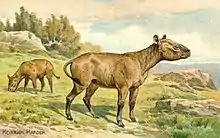 |
| ? H. sp. indeterminate | Wounded Knee Area.[1] | Rockyford Member.[1] | Partial mandible (SDSM 54183).[1] | A hyracodontid. |  | |
| Leptochoerus | L. sp. indeterminate | Wounded Knee Area.[1] | Fragment of ramus (SDSM 56101).[1] | A leptochoerid. | ||
| Leptomeryx | L. sp. indeterminate | Wounded Knee Area.[1] | Ramus fragments.[1] | A leptomerycine. | ||
| Mesoreodon | M. megalodon cf. sweeti | Wounded Knee Area.[1] | Partial cranium (SDSM 54220).[1] | An oreodont. | ||
| Miohippus | M. equiceps | Wounded Knee Area.[1] | Skull elements.[1] | An equid. | ||
| M. near equinanus | Wounded Knee Area.[1] | Jaw elements.[1] | An equid. | |||
| Nanotragulus | N. intermedius | Wounded Knee Area.[1] | Spread throughout the greater portion of the formation.[1] | Numerous jaw elements.[1] | A hypertragulid. | |
| N. cf. loomisi | Wounded Knee Area.[1] | Mandibular & maxillary fragments.[1] | A hypertragulid. | |||
| Oxydactylus | O. cf. wyomingensis | Wounded Knee Area.[1] | Skull elements.[1] | A camelid. | _1_(32312306045).jpg.webp) | |
| ?O. sp. indeterminate | Wounded Knee Area.[1] | Mandible fragments of adults.[1] | A camelid. |  | ||
Reptiles
Squamates
| Squamates reported from the Sharps Formation | ||||||
|---|---|---|---|---|---|---|
| Genus | Species | Location | Stratigraphic position | Material | Notes | Images |
| Amphisbaenidae | Genus indeterminate | Wounded Knee Area.[1] | 2 jaw fragments (SDSM 5897).[1] | A worm lizard. | ||
| Anguidae | Genus indeterminate | Wounded Knee Area.[1] | 30 jaw fragments (SDSM 5896).[1] | An anguid lizard. | ||
| Iguanidae | Genus indeterminate | Wounded Knee Area.[1] | 11 jaw fragments (SDSM 5829).[1] | An iguanid lizard. | ||
| Macrorhineura | M. skinneri | Wounded Knee, Shannon County, South Dakota.[11] | Anterior portion of skull (LACM 9249).[11] | A worm lizard. |  | |
| Peltosaurus | P. granulosus | Sharps Corner, South Dakota.[12] | Upper part of the formation.[12] | Multiple specimens.[12] | A glyptosaurine lizard also known from the Monroe Creek Formation. |  |
| ?P. sp. indeterminate | Wounded Knee Area.[1] | Jaw fragment (SDSM 5578).[1] | A glyptosaurine lizard. | |||
See also
References
- 1 2 3 4 5 6 7 8 9 10 11 12 13 14 15 16 17 18 19 20 21 22 23 24 25 26 27 28 29 30 31 32 33 34 35 36 37 38 39 40 41 42 43 44 45 46 47 48 49 50 51 52 53 54 55 56 57 58 59 60 61 62 63 64 65 66 67 68 69 70 71 72 73 74 75 76 77 78 79 80 81 82 83 84 85 86 87 88 89 90 91 92 93 94 95 96 97 98 99 100 101 102 103 104 105 106 107 108 109 110 111 112 113 114 115 116 117 118 119 120 121 122 123 124 125 126 127 128 129 130 131 132 133 134 135 136 137 138 139 140 141 142 143 144 145 146 147 148 Macdonald, J. R. (James Reid); Thomson, Albert Report of the expedition of 1906 to the Miocene on Pine Ridge Indian Reservation (1963). "The Miocene faunas from the Wounded Knee area of western South Dakota. article 3". Bulletin of the AMNH. 125. hdl:2246/1259.
{{cite journal}}: CS1 maint: numeric names: authors list (link) - ↑ Harksen, J. C.; Macdonald, J. R.; Sevon, W. D. (1961). "New Miocene Formation in South Dakota" (PDF). p. 2. Retrieved 2022-10-05 – via South Dakota Geological Survey.
- 1 2 3 4 5 6 7 8 9 10 11 12 13 14 15 16 17 18 19 20 21 22 23 24 Wang, Xiaoming; Tedford, Richard H.; Taylor, Beryl E. (1999). "Phylogenetic systematics of the Borophaginae (Carnivora, Canidae)". Bulletin of the AMNH (243): 9–391. hdl:2246/1588.
- 1 2 Barrett, Paul Z. (2016-02-09). "Taxonomic and systematic revisions to the North American Nimravidae (Mammalia, Carnivora)". PeerJ. 4: e1658. doi:10.7717/peerj.1658. ISSN 2167-8359. PMC 4756750. PMID 26893959.
- 1 2 3 4 5 6 7 8 9 10 11 12 Wang, Xiaoming (1994). "Phylogenetic systematics of the Hesperocyoninae (Carnivora, Canidae)". Bulletin of the AMNH (221). hdl:2246/829.
- 1 2 Tedford, Richard H.; Wang, Xiaoming; Taylor, Beryl E. (2009). Phylogenetic systematics of the North American fossil Caninae (Carnivora, Canidae). (Bulletin of the American Museum of Natural History, no. 325). [New York] : American Museum of Natural History. hdl:2246/5999.
- 1 2 Hunt, Robert M. (2001). "Small Oligocene amphicyonids from North America (Paradaphoenus, Mammalia, Carnivora)". American Museum Novitates (3331): 1–20. doi:10.1206/0003-0082(2001)330<0001:BAOTLL>2.0.CO;2. hdl:2246/2884. S2CID 83979855.
- 1 2 3 4 5 6 7 8 9 10 11 12 13 Hutchison, J. Howard (1972-12-29). "Review of the Insectivora from early Miocene Sharps formation of South Dakota". Contributions in Science. 235: 1––16. doi:10.5962/p.241219. ISSN 0459-8113. S2CID 134450974.
- 1 2 Korth, William W. (1994). "Middle Tertiary Marsupials (Mammalia) from North America". Journal of Paleontology. 68 (2): 376–397. doi:10.1017/S0022336000022952. ISSN 0022-3360. JSTOR 1306077. S2CID 130386546.
- 1 2 3 4 Parris, David C.; Green, Morton (1969). "Dinohyus (Mammalia: Entelodontidae) in the Sharps Formation, South Dakota". Journal of Paleontology. 43 (5): 1277–1279. ISSN 0022-3360. JSTOR 1302440.
- 1 2 Hembree, Daniel I. (April 30, 2007). "Phylogenetic revision of Rhineuridae (Reptilia: Squamata: Amphisbaenia) from the Eocene to Miocene of North America". The University of Kansas Paleontological Contributions (15): 1–20. doi:10.17161/PCNS.1808.3763. S2CID 59354440.
- 1 2 3 Scarpetta, Simon G. (October 2019). "Peltosaurus granulosus (Squamata, Anguidae) from the Middle Oligocene of Sharps Corner, South Dakota, and the Youngest Known Chronostratigraphic Occurrence of Glyptosaurinae". Journal of Vertebrate Paleontology. 39 (3): e1622129. doi:10.1080/02724634.2019.1622129. ISSN 0272-4634. S2CID 196690362.
- Various Contributors to the Paleobiology Database. "Fossilworks: Gateway to the Paleobiology Database". Retrieved 17 December 2021.
This article is issued from Wikipedia. The text is licensed under Creative Commons - Attribution - Sharealike. Additional terms may apply for the media files.